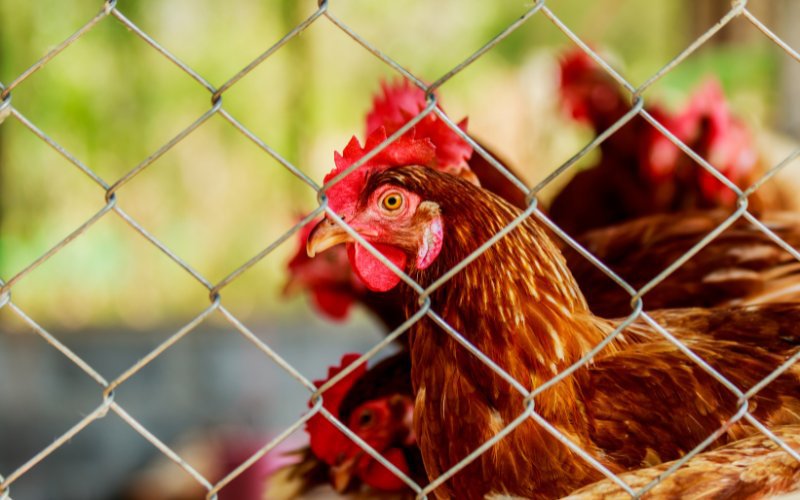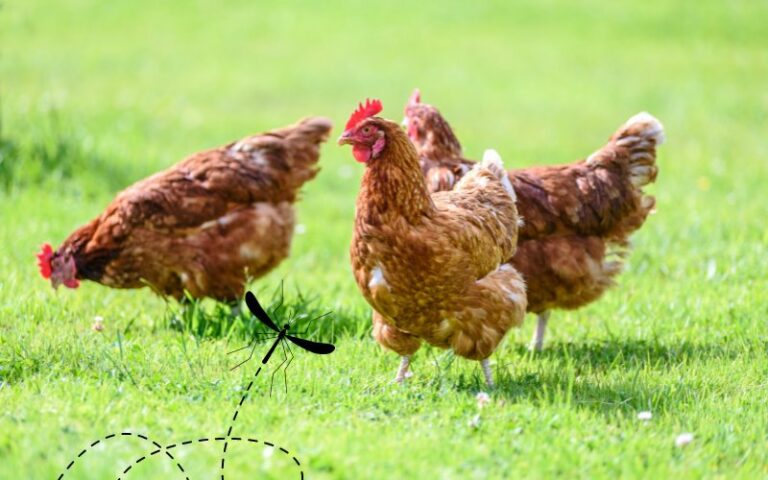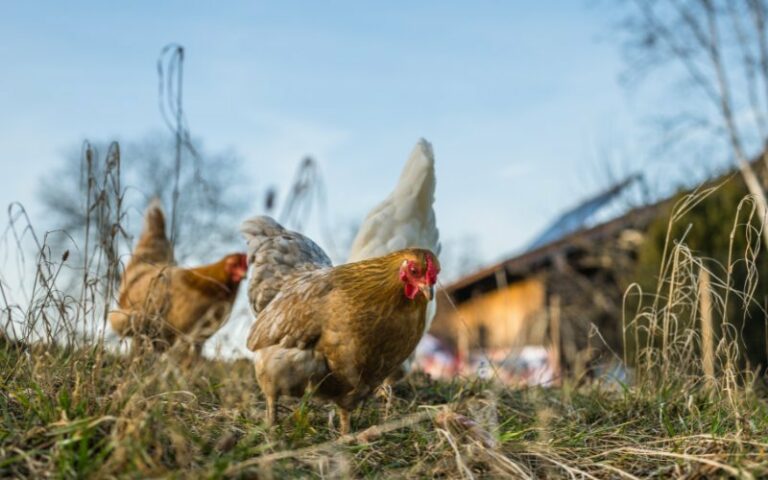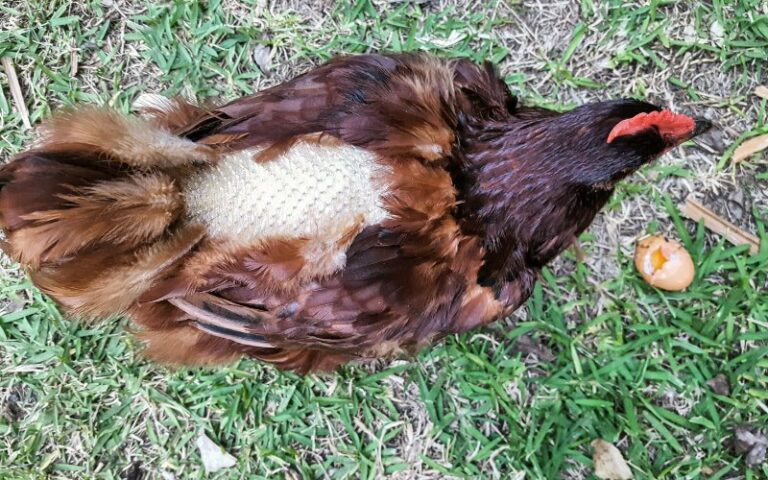Chicken Fence Height (How Tall is Tall Enough?)
Chicken fences come in a range of heights from 2-foot-tall rolls of plastic poultry mesh to rolls of welded wire 6 feet or more in height. How do you choose the right fence, at the right height, for your flock? Below you can learn the “easy answer” as well as the 7 factors you should consider if you want to know the exact fence height you should be considering and why.

How Tall Should a Chicken Fence Be? (The Short Answer)
How tall should a chicken fence be? Ideally, without a net or cover over the top, a chicken fence should be either standard welded wire or chicken wire of 6 feet in height or an electrified poultry net of at least 4 feet in height. Anything less than this runs the risk of predators getting in or chickens getting out.
Factors That Influence Optimum Chicken Fence Height
Below are the 7 factors that go into determining what the ideal fence height would be for your chicken pen or chicken run.
Predators – What Threats Are in Your Area?
Above all else, a fence is there to keep predators away from your chickens. To know how high your fence should be to defend your flock, it’s important to think about how the predators in your area can get to your chickens.
For example, foxes tend to prefer to dig under most fences and can climb straight up welded wire fences at or even above 6 feet. To counter foxes you need to have a foot of buried fence plus 5 feet of fence above ground. About 1-foot from the top of the fence, you would also want a hot wire (a line of electric fence), or to tilt the top of the fence out so that the fox reaches a dead end and cannot climb up and over. Possums and raccoons will also be deterred by this type of fence.
Other predators, like minks, badgers, and coyotes can be deterred with a fence of only about 4 feet but you will still need to bury at least 6 inches of additional fence or use a low string of electric fence wire to prevent digging.
Cover – Does Your Chicken Pen Include Cover?
Beyond predators that dig and climb, you also have to think about those that fly. Hawks, eagles, and owls can all target your flock- even in the middle of the day. There are 2 ways to combat this problem. You can use a shade, net, tarp, or large tree to discourage them and provide sufficient cover for your chickens while they’re outside. You could, alternatively, create a fence or wire “lid” for your chicken coop or run. A pen sealed up like this is the safest for your chickens.
Charged Fence – Are You Using Electric Fence or a Hot Wire?
Electric fence or mesh is the only way to go if you want a lighter, shorter, or portable chicken pen. Electrified poultry net is one of the easier types of fence to set up. It prevents climbing, digging, and usually comes just tall enough (4 feet) to discourage jumping. It’s also light enough to move around to different foraging spots.
If you only want a minimal amount of electric fence, a wire or two of it run on the outside of the pen, a few inches above the ground, and 1-foot from the top of any fence 4-foot or higher is sufficient. Strand- or tape-type electric fence should never be used on its own with chickens, no matter how close you string the fence.
Dogs, Scares, and Other Defenses – What Other Predator Defenses Do You Have?
If the only defense you have is a fence, it’s going to have to be tall. If you have an LGD (livestock guardian dog), another guardian animal, or some combination of other predator deterrents, you may be able to use a lower fence for a pen. Enclosed structures, like most chicken tractors and chicken runs, can still be as low as 3′.
The “Adventurous Type” – What Temperament Does Your Flock Have?
Beyond the problem of predators, it’s important to realize that chickens might not voluntarily stay inside of a fence, pen, or chicken run. If your flock is easily spooked, you have larger chicken varieties, your chicken pen has an open top, or you are using welded wire over a less stable form of fence then any pen under 4′ is unlikely to be a safe choice.
Flight Feathers – Do You or Do You Plan to Clip Your Chickens’ Wings?
Chickens may be known as “flightless” but this is a big misconception, especially for bantams, egg-laying, and heritage breeds. The only chickens that aren’t very good at flying, at least for short distances, are modern commercial chickens raised for meat.
Most heritage breeds and bantams can reach heights of up to 10 feet and glide for 30 to 50 feet. This is why trimming flight feathers is encouraged. If you regularly trim flight feathers, your chickens should easily stay within a 4-foot pen. If you do not plan on trimming their feathers and you are using the pen for containment in an area with a high level of danger from traffic or predators, a 6-foot-tall chicken fence is more appropriate.
Escape – What Are the Risks If A Chicken Escapes?
Once you have considered all of the above factors, the last thing to think about is the risk of what would happen if a chicken escapes. Most chickens do tend to stay near their coop, flock, and feeding area even if they do happen to escape, though there will always be exceptions.
How quickly would you be able to catch and return a chicken to its pen? Do you have anything that can protect the chicken outside of its pen? Are there nearby dangers, such as a hawk nest or a busy road, that could cause immediate harm? If the risk is high for escaped chickens, a 6′ tall fence or an enclosed chicken run may be the best option.
Different Chicken Fence Heights for Different Scenarios
There are 4 categories of heights for chicken pen fences or chicken runs. Below you can find a summary of what situation each fence type could work well for.
3-Foot and Under Chicken Fence
There are only two situations in which a chicken fence 3-foot or under should be used. The first situation is when you want to outline a light grazing pen or temporary run within a large pasture or garden. A low fence should encourage a more docile flock to concentrate on foraging within a specified area. A 3-foot fence could also be used as part of a low chicken run or chicken tractor with a sunshade or other lightweight lid or covering.
3- to 4-Foot Chicken Fence
If you are looking at using an electrified poultry net or setting up a day pen for chickens that will be either monitored by a human or a livestock animal for most of the day, a 3-foot to 4-foot pen should be fine. This type of pen could also be fine for a less monitored, urban area- especially if your chickens are surrounded by an even taller backyard fence.
5- to 6-Foot+ Chicken Fence
How tall of a fence will keep chickens in and predators out? A 5 to 6′ fence is the surest bet for keeping your chickens both contained and safe. However, it’s also important to consider other predator deterrents, especially if you aren’t planning to keep your chickens in at night. No fence alone will prevent all predators, no matter how tall. Burying the first foot of a 6-foot fence is a good start, with electrification being another option.
Complete Enclosure
Beyond a general height requirement, many chicken owners and farmers will choose an enclosed chicken run that is just tall enough to walk into and clean. This is the safest option and usually results in a chicken run height of 5′ to 6′. If, however, you are building your chicken run on a frame that can be lifted or tilted to be cleaned, you could build your chicken run so that it has a height of as little as 2.5 feet.






